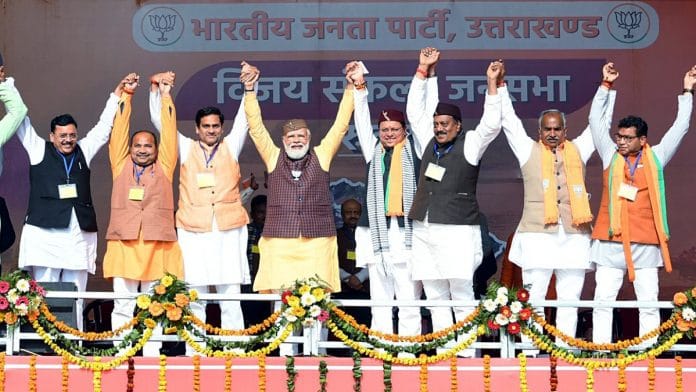New Delhi: The BJP’s gambit of replacing two chief ministers in Uttarakhand in a span of four months last year seems to have paid off. Early trends available on the Election Commission of India’s (ECI) website indicate that the party seems to have bucked the state’s anti-incumbency trend to retain power.
According to ECI data available at 1 pm, the Bharatiya Janata Party (BJP) is leading in 44 seats, and the Congress in 23, while Mayawati’s Bahujan Samaj Party (BSP) is leading in one seat of the 70-member assembly.
In 2017, the BJP had swept the state elections, winning 57 seats. The party had polled 46.51 per cent votes then, compared to the Congress’ 33.5 per cent.
In the 2019 Lok Sabha polls, the BJP bettered its 2017 record in Uttarakhand and won all five Lok Sabha seats there, with around a 61 per cent voteshare. While it improved its position in the state in the wake of the Modi wave, the Congress’ performance declined further in the state that year, with its vote-share reducing to 31.4 per cent.
Also Read: So many ex-CMs, so little campaigning: BJP’s old guard is missing in action in Uttarakhand
What worked for BJP
The BJP fought this election under the motto ‘Abki baar, 60 paar (this time, 60 plus)’ slogan this time round. According to a senior BJP leader, the campaigning done by Prime Minister Narendra Modi, especially during the last few days before voting, seems to have done the “magic” for the BJP. The PM addressed 148 virtual and three physical rallies in the state.
The party had put focus on the “double-engine” BJP government and work done by the Centre for Uttarakhand, pointing to free ration, Covid-19 vaccination and welfare schemes.
According to state BJP leaders, despite battling anti-incumbency, the party kept the focus on PM Modi and the campaign too highlighted work done by the Centre.
Switching chief ministers
The party changed CMs twice in four months last year — which had become a poll issue. In March 2021, Trivendra Singh Rawat had resigned as Uttarakhand CM after almost four years in office, following mounting pressure on the BJP leadership to remove him, owing to his “uninspiring leadership” and alleged lack of control on the state’s administration.
Many had pointed out then itself that this could affect the BJP’s poll prospects in the 2022 state elections.
Trivendra Rawat was replaced by Tirath Singh Rawat, who too had to leave less than four months into his tenure, making way for Pushkar Singh Dhami, who became the 20-year-old state’s 10th CM in July last year.
What went wrong with Congress
According to a senior Congress leader, factionalism was one of the major reasons behind the party’s poor performance in the state in 2017, and this time, the party fought in a “united” manner under former CM and veteran leader Harish Rawat, despite differences in the state unit.
However, this still did not seem enough because despite campaigning by party leaders Rahul Gandhi and Priyanka Gandhi Vadra, the voters seem to have sided with the BJP.
“It was clear to every single candidate and leader that if we had to win, we had to keep our internal differences aside. The message was clear and everyone, despite having some issue or another, ensured that they remained focused on winning. We are still confident of doing well,” added the Congress leader.
The Congress kept the focus on local issues of unemployment, creation of government jobs, and inflation, and did not allow the BJP to shift to talk of “temple and appeasement politics”, despite the ‘Muslim university’ controversy surfacing days before the assembly elections.
“Polarisation of votes could have been a major issue even as we tried to keep the focus on real issues, the BJP tried to make it into a Hindu-Muslim election,” said another senior Congress leader.
Also Read: Why Rita Bahuguna Joshi’s son Mayank joining SP was no surprise: It’s Bahuguna family tradition






